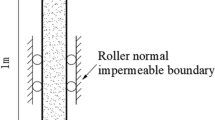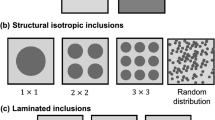Abstract
This paper focuses on the meso-scale computational modeling of the thermo-mechanical response of asphalt concrete mixes using for the first time a compressive coupled thermo-viscoelastic, thermo-viscoplastic, and thermo-viscodamage constitutive model. Asphalt concrete is represented by two-dimensional images of the microstructure that consist of three phases: aggregate, matrix, and interfacial transmission zone (ITZ). The matrix and ITZ are considered as thermo-viscoelastic, thermo-viscoplastic, and thermo-viscodamaged materials, while the aggregate is considered to be elastic. The effects of variation in aggregate shape, distribution, volume fraction, ITZ strength, strain rate, and temperature on the degradation and micro-damage patterns in asphalt concrete are investigated under uniaxial tension, compression, and repeated creep-recovery loading conditions. It is concluded that the aggregate volume fraction and distribution significantly influence the micromechanical response of asphalt concrete. Additionally, the results indicate that the constitutive model presented in this paper can provide a computational tool for predicting the overall macroscopic behavior of asphalt concrete based on the distribution of the microstructure constituents and the properties of these constituents. As such, the results of this computational model can be used to guide the design of asphalt concrete mixtures.

























Similar content being viewed by others
References
Abaqus.: Version 6.8., Providence, RI (2008)
Abu Al-Rub, R.K., Voyiadjis, G.: Gradient-enhanced coupled plasticity-anisotropic damage model for concrete fracture: computational aspects and applications. Int. J. Damage Mech. 18, 115–154 (2009)
Abu Al-Rub, R.K., Masad, E.A., Huang, C.W.: Improving the sustainability of asphalt pavements through developing a predictive model with fundamental material properties, Final Report submitted to Southwest University Transportation Center, Report # SWUTC/08/476660-0007-1 (2009)
Abu Al-Rub, R.K., Darabi, M.K., Little, D., Masad, E.A.: A micro-damage healing model that improves prediction of fatigue life of asphalt mixes. Int. J. Eng. Sci. 48, 966–990 (2011)
Chang, G., Meegoda, J.: Micromechanical model for temperature effects of hot-mix asphalt concrete. Transp. Res. Rec. 1687, 95–103 (1999)
Collop, A., Scarpas, A., Kasbergen, C., de Bondt, A.: Development and finite element implementation of stress-dependent elastoviscoplastic constitutive model with damage for asphalt. Transp. Res. Rec. 1832(1), 96–104 (2003)
Dai, Q., Sadd, M.: Parametric model study of microstructure effects on damage behavior of asphalt samples. Int. J. Pavement Eng. 5(1), 19–30 (2004)
Dai, Q., Sadd, M., You, Z.: A micromechanical finite element model for linear and damage-coupled viscoelastic behaviour of asphalt mixture. Int. J. Num. Analyt. Methods Geomech. 30(11), 1135 (2006)
Darabi, M.K., Abu Al-Rub, R.K., Masad, E., Huang, C., Dallas, L.: A thermo-viscoelastic-viscoplastic-viscodamage constitutive model for asphalt materials. Int. J. Solids Struct. 48, 191–207 (2011)
Darabi, M.K., Abu Al-Rub, R.K., Masad, E.A., Little, D.: Thermodynamic based model for coupling viscoelastic, viscoplastic, and viscodamage constitutive behavior of asphalt mixtures. Int. J. Num. Analyt. Methods Geomech. (in press) (2010)
Dessouky, S., Masad, E., Little, D., Zbib, H.: Finite-element analysis of hot mix asphalt microstructure using effective local material properties and strain gradient elasticity. J. Eng. Mech. 132, 158 (2006)
Haj-Ali, R., Muliana, A.: Numerical finite element formulation of the Schapery non-linear viscoelastic material model. Int. J. Num. Methods Eng. 59(1), 25–45 (2003)
Huang, C., Masad, E., Muliana, A., Bahia, H.: Nonlinearly viscoelastic analysis of asphalt mixes subjected to shear loading. Mech. Time-Depend. Mater. 11(2), 91–110 (2007)
Huang, C.W., Abu Al-Rub, R.K., Masad, E.A., Little, D.N.: Three dimensional simulations of asphalt pavement performance using a nonlinear viscoelastic-viscoplastic model. ASCE J. Mater. Civil Eng. 23, 56–68 (2011)
Kachanov, L.M.: On time to rupture in creep conditions (in Russian). Izviestia Akadamii Nauk SSSR, Otdelenie Tekhnicheskikh Nauk 8, 26–31 (1958)
Kim, Y.R., Lutif, J.E.S., Allen, D.H.: Determining representative volume elements of asphalt concrete mixtures without damage. Trans. Res. Rec. 2127, 52–59 (2009)
Lai, J., Bakker, A.: 3-D Schapery representation for non-linear viscoelasticity and finite element implementation. Comput. Mech. 18(3), 182–191 (1996)
Lemaitre, J., Chaboche, J.: Mechanics of Solid Materials. Cambridge University Press, Cambridge (1990)
Li, X.J., Marasteanu, M.O., Kvasnak, A., Bausano, J., Williams, R.C., Worel, B.: Factors study in low-temperature fracture resistance of asphalt concrete. J. Mater. Civil Eng. 22(2), 145–152 (2010)
Luo, H., Zhu, H., Miao, Y., Chen, C.: Simulation of top-down crack propagation in asphalt pavements. J. Zhejiang Univ. Sci. A 11(3), 223–230 (2010)
Mahmoud, E., Masad, E., Nazarian, S.: Discrete Element Analysis of the Influences of Aggregate Properties and Internal Structure on Fracture in Asphalt Mixtures. J. Mater. Civil Eng. 22, 10 (2010)
Masad, E., Dessouky, S., Little, D.: Development of an elastoviscoplastic microstructural-based continuum model to predict permanent deformation in hot mix asphalt. Int. J. Geomech. 7, 119 (2007)
Masad, E., Somadevan, N., Bahia, H., Kose, S.: Modeling and experimental measurements of strain distribution in asphalt mixes. J. Transp. Eng. 127, 477 (2001)
Masad, E., Tashman, L., Little, D., Zbib, H.: Viscoplastic modeling of asphalt mixes with the effects of anisotropy, damage and aggregate characteristics. Mech. Mater. 37(12), 1242–1256 (2005)
Mo, L., Huurman, M., Wu, S., Molenaar, A.: Investigation into stress states in porous asphalt concrete on the basis of FE-modelling. Finite Elem. Anal. Des. 43(4), 333–343 (2007)
Mo, L., Huurman, M., Wu, S., Molenaar, A.: 2D and 3D meso-scale finite element models for ravelling analysis of porous asphalt concrete. Finite Elem. Anal. Des. 44(4), 186–196 (2008)
Papagiannakis, A., Abbas, A., Masad, E.: Micromechanical analysis of viscoelastic properties of asphalt concretes. Transp. Res. Rec. 1789(1), 113–120 (2002)
Perzyna, P.: Thermodynamic theory of viscoplasticity. Adv. Appl. Mech. 11, 313–354 (1971)
Sadd, M., Dai, Q., Parameswaran, V., Shukla, A.: Simulation of asphalt materials using finite element micromechanical model with damage mechanics. Transp. Res. Rec. 1832(1), 86–95 (2003)
Schapery, R.: On the characterization of nonlinear viscoelastic materials. Polym. Eng. Sci. 9(4), 295–310 (1969)
Tashman, L., Masad, E., Little, D., Zbib, H.: A micro structure-based viscoplastic model for asphalt concrete. Int. J. Plasticity 21(9), 1659–1685 (2005)
Woldekidan, M.: Performance study of C-Fix in PAC using a 2D finite element model. M.Sc. Thesis, Delft University of Technology, The Netherlands (2006)
You, Z., Adhikari, S., Dai, Q.: Three-dimensional discrete element models for asphalt mixtures. ASCE J. Eng. Mech. 134(12), 1053–1063 (2008)
Acknowledgments
Authors would like to acknowledge the financial support provided by Qatar Nation Research Fund (QNRF) through the National Priority Research Program project 08-310-2-110. The QNRF funding supported the developed meso-scale model presented in this study. In addition, the authors acknowledge the support of the US Federal Highway Administration through the Asphalt Research Consortium (ARC). The ARC funding supported the development of the constitutive model presented in this study. Also, fruitful discussions with Mr. Masoud Darabi and Dr. Sun-Myung Kim from Texas A&M University about the meso-scale simulations are acknowledged.
Author information
Authors and Affiliations
Corresponding author
Rights and permissions
About this article
Cite this article
Abu Al-Rub, R.K., You, T., Masad, E.A. et al. Mesomechanical modeling of the thermo-viscoelastic, thermo-viscoplastic, and thermo-viscodamage response of asphalt concrete. Int J Adv Eng Sci Appl Math 3, 14–33 (2011). https://doi.org/10.1007/s12572-011-0028-9
Published:
Issue Date:
DOI: https://doi.org/10.1007/s12572-011-0028-9




